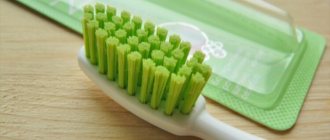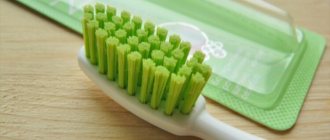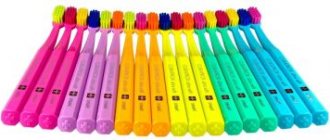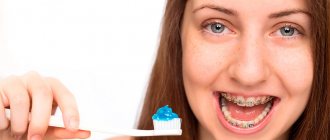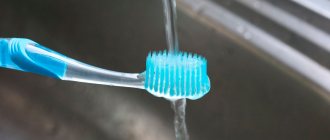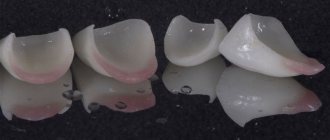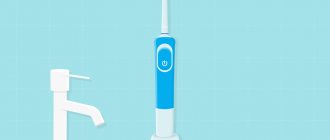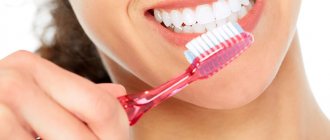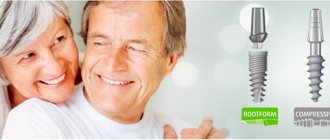Many people buy toothbrushes without thinking about their technical characteristics and based only on price. However, they differ in many parameters: the material and stiffness of the bristles, the shape and size of the head, etc. To choose the right toothbrush, you should take into account as many criteria as possible. Let's tell you more about them.
In this article
- Which toothbrush to choose
- What shape and size should a toothbrush be?
- How to choose a toothbrush based on bristle material
- What toothbrush is best?
- Which toothbrush to choose - soft or hard?
- How to choose a brush based on the shape of the bristles
- Additional functions of toothbrushes
- Hardness of electric toothbrushes
- Which toothbrush to buy
- How often to change the brush
- How to care for your brush
When buying a toothbrush, do we think about the stiffness of the bristles, the size of the head, the material and its other parameters? As a rule, we choose them based on external data, based on the fact that one model is suitable for adults, the other for children. However, the quality of cleaning the oral cavity depends on a properly selected toothbrush. If it is not suitable for medical parameters and individual anatomical features, it cannot be used, as there is a risk of damage to the gums and enamel. In addition, brushing your teeth with such a brush will simply be inconvenient.
Understanding this issue is not so difficult. There are several criteria that will help you choose the right toothbrush.
What shape and size should a toothbrush be?
Toothbrushes are available in different sizes and head shapes. Please note the following features:
- The head should cover a maximum of 2-2.5 teeth. Only in this case will cleaning be effective. The head is too large and does not allow the bristles to penetrate into the interdental spaces.
- The length of the toothbrush head for children should be 18-25 mm, and for adults - 30 mm maximum. The child’s teeth are just growing, the jaw is not yet formed, so the large head can injure the gums. Small brushes are not useless for an adult, but brushing teeth with them is inconvenient. In addition, you will have to spend a lot of time on the procedure.
- The head should have a rounded shape to minimize the risk of injury to the oral mucosa.
- The area connecting the head with the handle must be movable so that the spring effect is triggered, due to which the pressure on the teeth and gums is reduced. Almost all modern brushes have a flexible neck to control pressure.
Brushes differ in the number of tufts. The larger the head, the more bristles it is equipped with. Children under 6 years old need to choose models with 23 bundles, teenagers - with 30-40, adults - with 45-55 bundles. People with braces should have a multi-tuft brush (more than 55). Their number is indicated on the packaging. It is not always possible to quickly find this parameter among the information written in small print. However, the quality of teeth cleaning depends on this, so it is better not to ignore this feature of the brush.
As for the handle, it just needs to be comfortable. It is advisable to choose a model with a rubberized coating that will not slip out of your hand.
How to choose the right brush
We have looked at the main characteristics of various toothbrush options, and now let’s move on to specific recommendations on how to correctly evaluate the quality and effectiveness of products. Let's talk separately about the choice for adults and children.
Recommendations for adult patients
When considering various options, you need to pay attention to criteria such as the degree of rigidity, the position of the bristles, their length and number. Moreover, the shape and length of the handle are also selected taking into account the condition of the teeth and gums, and the patient’s age. It is best to talk to your dentist in advance and get professional recommendations in this regard. The simplest and best option in terms of price and efficiency would be a conventional mechanical brush with synthetic bristles made of nylon. Natural bristles become dirty faster, bacteria accumulate in them, multiply and quickly render the tool unusable.
It is better if there is a ribbed surface on the back of the working area - it is intended to clean the tongue, which, by the way, accumulates the most bacteria. If you have the financial means and there are no problems with enamel sensitivity, you can give preference to an electric or ultrasonic model. We’ll talk more about assessing rigidity, material and size in the next section, but for now let’s move on to choosing the most suitable option for the child.
The ribbed surface on the back of the brush will help clean your tongue.
How to choose a brush for a child
By the age of 1.5-2 years, a baby usually already has about 15 teeth in his mouth. This is the best time to start getting him into the habit of brushing his teeth regularly twice every day. In this case, it is necessary to show the child to a specialist as soon as his first teeth begin to cut. And even before they appear, you should keep the baby’s mouth clean by regularly wiping the gums and mucous membranes using special finger wipes.
When a sufficient number of teeth appear, parents will be faced with the question: which brush is best to buy for their child. To avoid making a mistake with your choice, pay attention to the following points:
- appearance – the baby needs to be interested, and a bright, attractive design will help with this. With a brush of an unusual shape and colorful colors, the child will be more willing to brush his teeth every morning and evening,
- bristle parameters - for baby teeth, you need to ensure uniform pressure, and in this regard, even bristles are the best option. Length – no more than 11 mm. Medium and soft hardness is suitable for children - in this regard, you need to consult a dentist to take into account the current state of the enamel,
- working area - the head should not be too large, otherwise it will be uncomfortable to use and there will be a risk of damaging the mucous membrane. The working area should cover 2-3 children's teeth, and it is better to give preference to a round shape,
- handle – should be comfortable, optimal size for a child’s hand. It is better if it is covered with non-slip material. As you grow older, the length of the handle should increase.
Be responsible when choosing a toothbrush for your child.
Experts in the field of pediatric dentistry pay special attention to the change in primary occlusion. During this period, it is better to purchase a brush with multi-level bristles. The product must be replaced with a new one every 3 months.
How to choose a toothbrush based on bristle material
Today, products made from natural materials are popular. Some people also prefer to buy toothbrushes with natural bristles, such as pig bristles.
However, dentists claim that it is better to abandon this idea for the following reasons:
- In bristles made from natural material, microorganisms multiply twice as fast. You will have to change such a brush more often - almost every month.
- The tips of pig bristles cannot be made rounded, so they can be traumatic. These brushes are not suitable for those with sensitive gums. It is also better not to buy them for children.
- Natural bristles quickly become shaggy: the hairs soften, flake and spread to the sides. The brush loses its shape and functionality. You won't be able to brush your teeth properly with it. In addition, the soft tissue of the oral cavity can be damaged by the plastic head.
Dentists advise choosing toothbrushes with nylon bristles and a safe plastic handle. It is safe for teeth, suitable for almost everyone and easier to dispose of without harming the environment. Now we’ll find out which toothbrush hardness is best to choose.
How to find out the degree of hardness: decoding the markings
You should choose a toothbrush from a trusted manufacturer.
It is better if it is a company with global experience.
Check that the packaging is intact and there is no damage or dents on the fibers.
Next, you need to look for a designation of the degree of hardness or softness. They are: sensitive, soft, medium, hard, extra-hard.
Read more.
- Sensitive translated from English means sensitive. Suitable for people with various gum diseases (gingivitis, stomatitis, periodontal disease, hyperesthesia, etc.).
- Soft translated from English is soft. Ideal for people whose gums are prone to inflammation and swelling. Typically, owners of this quality are distinguished by thin skin, a tendency to irritate the mucous membranes and the close location of blood vessels on the face.
- Medium translated from English is average. If a person has good health, can handle hot and cold well, and doesn’t even know what blood is when brushing his teeth, this brush will be ideal for him.
- Hard translated from English means tough, hard. If the condition of your oral cavity is normal, a toothbrush with medium-hard bristles will be optimal for you, but this toothbrush will not cause injury.
- Extra-hard translated from English - extra-hard. In many countries, toothbrushes with this hardness have been discontinued. They are suitable for those whose health can be defined as impeccable. Buyers often mistakenly prefer such bristles, believing that they clean their teeth better. Unfortunately, it is not. Auxiliary products will help improve the quality of teeth cleaning: rinsing solutions, dental floss, ultrasonic brushes. And hard bristles will only disturb the gums, which will definitely not improve the health of the oral cavity.
In fact, toothbrushes labeled extra-hard are the cheapest and use the least amount of manufacturing resources. If you add a couple more plastic decoy blocks, the cost is greatly underestimated, and the buyer mistakes the “sophisticated” model for a high-tech one.
What toothbrush is best?
Toothbrushes are divided into the following types according to the stiffness of the bristles:
- Very soft. An excellent option for those with bleeding gums, patients after dental surgery, diabetics and pregnant women. The risk of injury to soft tissues, even if they are vulnerable, is practically absent.
- Medium hardness. Suitable for all people with a healthy oral cavity. Most brushes on the market fall into this category.
- Tough. Used temporarily to remove plaque caused by smoking or frequent drinking of coffee and tea. Constantly using a hard brush is harmful: you can damage the enamel or gums.
- Very tough. Prescribed by a doctor when installing orthodontic structures. It is not recommended to purchase such brushes without the approval of a dentist.
What toothbrush hardness is best for you depends on your medical indications. Let us describe in more detail the features of soft and hard bristles.
Modifications according to the nature of the placement of bristles
- Mono-beam. With one tuft of bristles located at the end of the working surface. Used for cleaning orthodontic and orthopedic structures.
- With a small number of beams (most often there are 7). One long bunch is located in the center, and the rest (lower ones) are in a circle. Indicated for people who wear orthopedic and orthodontic structures (including implants, metal-ceramic crowns), as well as for patients with a jaw fracture or crowded teeth.
- Double row. Brushes with two rows of tufts. They are used in the same cases as small-beam brushes, and also as an additional brush for more thorough cleaning of plaque.
- Three-row. Suitable for adults and children.
- Four-row. The most common type recommended for adults.
Which toothbrush to choose - soft or hard?
A soft brush gently removes food debris and plaque without causing any strong impact on the tissue. They are indicated for use in the following cases:
- age up to 12 years;
- increased gum sensitivity;
- abrasion of tooth enamel;
- diabetes;
- blood clotting problem;
- tooth mobility;
- pregnancy;
- a number of periodontal diseases.
However, such a brush is useless for smokers, coffee drinkers, and teeth that are prone to plaque formation. Also, soft bristles do not allow you to clean the interdental spaces if they are too small. In these cases, it is better to choose a toothbrush with stiffer bristles. It has several undeniable advantages:
- removes plaque and surface deposits on teeth and gums;
- better cleanses the interdental spaces from food debris and germs;
- prevents darkening of enamel when drinking coffee and smoking;
- allows for better cleaning of orthodontic structures.
The downside of a hard brush is the presence of contraindications to its use, including abrasion of enamel, sensitivity of the gums and poor blood clotting.
Advantages and disadvantages
A feature of hard brushes is the presence of dense bristles with a large diameter . The degree of hardness must be indicated on the product packaging.
Sometimes manufacturers combine the type of bristles so that one brush has areas of harder or softer bristles.
For enhanced oral hygiene, people with sensitive gums are recommended to use products with soft, hard bristles.
Note! The advantages of rigid models include:
- wide range of models;
- Possibility of use for people with braces and dentures;
- effective removal of plaque after smoking and coffee;
- large cleaning surface;
- deep and gentle cleansing of hard-to-reach places.
As for the shortcomings , it is worth adding to them
- abrasion of hard dental tissues;
- likelihood of gum injury;
- can only be used by people with strong and healthy gums and teeth;
- poor penetration into interdental spaces and under the gums due to insufficient flexibility of the bristles.
You should know! The use of a device with hard bristles is allowed for adults and children over 12 years of age.
How to choose a brush based on the shape of the bristles
The bristles of a toothbrush can be single-level, two-level, three-level and multi-level. Research shows that multiple levels of bristles provide better cleaning between teeth and gum pockets.
Based on the arrangement of the beams, three types of brushes are distinguished:
- Hygienic: with even and straight bundles of the same length. This is a very ordinary brush with minimal functionality. Usually such models are bought for children.
- Preventive: the beams are located in different directions, have different lengths and even rigidity. There may be rubber bristles on the sides of the brush that massage the gums while brushing your teeth.
- Special: designed for cleaning braces, implants and other structures. Such brushes are sold in pharmacies and can be made to order. It is better to buy them after consulting a dentist.
These are the main parameters of toothbrushes. Today, many models are available with additional functions. If you wish, you can choose a good brush that will massage your gums, clean your tongue, etc.
All types of toothbrushes today - regular, electric, ionic, ultrasonic, etc.
Once every few months we go to the store (or pharmacy) and are faced with a difficult choice - which brush to choose that is inexpensive, cleans well, and doesn’t “cut” our gums.
And, as a rule, we take the first one we come across at a reasonable price, because “who cares!”
But there is a difference. And not only the cleanliness of the teeth, but also the quality of the enamel, the condition of the gums, etc. will depend on the correct choice of brush.
Therefore, before you go for a brush, study the basic rules of choice.
Additional functions of toothbrushes
These additional features include:
- Rubber inserts on the handle that prevent it from slipping out of your hand.
- Embossed pad for cleaning the tongue and cheeks, located on the back of the head.
- An indicator of wear is bristles, which differ in color from the main mass of the tufts. If they fade, the brush needs to be replaced.
- Ribbed surface or rubber bristles for gum massage.
Some brushes release silver ions during use, which enhance the whitening effect of toothpastes. With their help it is easier to get rid of plaque.
Types of nozzles and their characteristics
During your consultation with your dentist, be sure to ask which brush is best to choose in your particular case, and which mode is recommended for you. There are models that perform only horizontal or rotational movements - they are not recommended for cases of hyperesthesia or inflamed gums. If we talk about the overwhelming majority, then the optimal choice would be a model with a round or oval nozzle up to 30 mm in size. In this case, you can choose an option in which the bristles will perform reciprocating movements and sweeping (2D) or reciprocating rotation with vertical pulsation.
Below are the main types of attachments for electrical devices:
- universal – for daily use, with medium-hard bristles,
- bleaching – the pile is treated with a special composition with a bleaching effect, not suitable for permanent use,
- for teeth with increased sensitivity – soft bristles, suitable also for sensitive gums prone to bleeding,
- orthodontic – for braces, multi-level bristles with piles of varying density and diameter,
- for treating interdental spaces - single-tuft, the pile is cut at an angle, used to remove plaque and food debris between teeth, indicated for crowding.
The photo shows the types of attachments
. There are special children's attachments for cleaning the surface of the tongue and mucous membranes, for people with implants, dentures and veneers. In any case, you should talk to your doctor before purchasing.
Hardness of electric toothbrushes
Electric toothbrushes, which are beginning to become popular among domestic buyers, differ from each other in even more parameters than conventional brushes. However, their hardness level is exactly the same: electric brushes can be soft, medium hard, or very hard. Selection is made based on medical indications.
The advantage of such a device is that you can change the attachments. They can be different: standard, for delicate cleansing, orthodontic structures, tongue cleaning, gum massage, etc. The device itself can be one for the whole family. With careful use, it will last for several years - it all depends on the specific model. However, everyone should have their own nozzle, at least a standard one.
Which electric toothbrush to choose depends not only on the indications, but also on financial capabilities. Sound and ultrasonic devices are considered the most effective. They clean the oral cavity better and are able to get rid of plaque. Devices powered by ultrasound can even lighten the enamel a little - by 1-2 tones. The more functions an electric brush has, the more expensive it is.
Varieties
Stay up to date! According to their purpose, toothbrushes are divided into:
- classic. Recommended for daily hygiene. These include products indexed medium and hard;
- therapeutic and preventive. Used for specific areas of the oral cavity. A good choice would be products with combined bristles;
- highly specialized. They are used to care for dentures and various orthodontic structures (braces). For these purposes, products marked extra hard are used.
For your information! According to the type of action, devices are divided into:
- classic mechanical. When used correctly, they quickly and effectively remove food debris and other contaminants. Their advantages include: affordable cost, simplicity and ease of use;
- electric with a moving head. They operate from a small built-in motor and are often equipped with a timer. Their positive aspects include saving free time and effort when brushing your teeth. They effectively soften and remove plaque thanks to their reciprocating and rotating movements. In most models, you can independently adjust the speed of rotation of the head;
- sound. They appeared on the market relatively recently and work using sound waves. In such models, the bristles rotate at a speed of 24 thousand revolutions per minute and penetrate even the most inaccessible places;
- ultrasonic. Their operating principle is very different from other models. Using a sound wave, they destroy plaque, eliminate gum inflammation, and neutralize pathogens. They are able to penetrate into the deepest and most distant places of the tooth surface. Their advantages include gentle cleansing of the oral cavity and elimination of unpleasant odor. But such a brush can be used no more than 2-3 times a week. It is contraindicated for people suffering from epilepsy and heart disease.
Which toothbrush to buy
Let's summarize the above. To choose the right toothbrush, consider the following criteria:
- Age. Soft brushes with an 18 mm head are suitable for children; for adults, medium-hard models with up to 55 tufts are suitable.
- Oral health. If there are contraindications to hard brushes, buy models with soft bristles. When choosing an electric teeth cleaning device, consult your dentist.
- Availability of orthodontic structures. Special brushes are available for cleaning braces, crowns, implants and dentures. It is impossible to carry out high-quality cleansing with the help of ordinary ones. At the same time, there is a risk of developing caries and infectious processes behind the metal elements of braces.
In addition, try not to skimp on hygiene products. Dental treatment, tartar removal, and other dental procedures are expensive. If you carefully monitor the condition of your oral cavity and buy only high-quality brushes, and not the cheapest ones, you will have to treat your teeth less often.
Types of brushes according to the method of actuation
Manual
The most common ones, familiar to all of us.
Electrical
Their bristles are driven by an electric motor powered by a battery or battery.
There are different types of electric brushes:
- standard mechanical (perform from 5 to 30 thousand reciprocating and pulsating movements per minute);
- sonic electric (the bristles perform approximately 18 thousand movements per minute under the influence of sound vibrations, due to which it is possible to loosen the attachment of plaque to the enamel);
- ionic electric (release negatively charged ions, normalizing the acidity of the oral cavity and accelerating the saturation of the enamel with calcium and fluorine, which are included in the paste);
- electronic (with displays, pressure sensors, timers).
Ultrasonic
The bristles make approximately 100 million movements; during cleaning, the brush emits an ultrasonic wave, under the influence of which plaque is destroyed.
Why do you need brushes with a timer?
Advice from a dentist Most people don't brush their teeth for even a minute.
And for the cleaning process to be effective, this process... Published by dentist Oleg Konnikov on January 20, 2016
How often to change the brush
Doctors recommend changing the brush for an adult every 2-3 months, for a child - a month after the first use. Even if it is in excellent condition, it will still have to be thrown away. Brushes often fail prematurely because they are not always handled with care. They need to be replaced if they become shaggy, the bristles fall out and delaminate. Using them is useless and dangerous, as you can injure your gums and enamel.
Nozzles from electric brushes last a little longer - up to 4 months. Some have a wear indicator. If the blue hairs start to lighten, it's time to replace the device head.
Selecting cleaning head parameters
The main functional part of a toothbrush is the head, so you should choose it very carefully. It is believed that models with a small cleaning head are more effective at removing plaque and other contaminants. With their help, you can clean hard-to-reach areas, distant teeth, including wisdom teeth. A large cleaning head is less effective at such tasks because its size makes it difficult to control.
The size of the cleaning head is selected based on the age of the user:
- Children's brushes have an optimal length of the working part of 18-25 mm and a width of 7-9 mm.
- Adults are 25-30 mm long and 7.5-11 mm wide.
When choosing the optimal size of the cleaning head, ensure that it covers a maximum of 2-3 teeth. In addition to length and width, the number of tufts of bristles differs between cleaning heads. In children's models there should be 23, in teenagers - 39-40, in adults - 48-55.
It is better to give preference to round cleaning heads. They are considered safer and more maneuverable. Rectangular heads are more bulky and can damage the oral mucosa, so they should not be chosen for children, and adults should use them with caution.
Dentists recommend changing your toothbrush every 2-3 months, because over time, germs accumulate on it, and wear of the bristles reduces the quality of cleaning by 50%. To remember to change your toothbrush promptly, you can choose a model with an expiration indicator: as it wears, its colored bristles will lose color.
How to care for your brush
After brushing your teeth, rinse it well under running water to remove any remaining food. After this, blot the bristles with a dry cloth and place them on a stand or in a special glass away from the brushes of other family members. Place it vertically so that the water drains from the bristles and they have time to dry before the next procedure. Once every 10 days, treat the head in a disinfectant solution. If you drop your brush in a dusty place, throw it away and buy a new one.
In our online store you can order a regular or electric brush, as well as other oral care products.
And there are several reasons:
- In such brushes, bacteria multiply 2 times faster, and, accordingly, they will also have to be changed more often.
- In addition, the tips of pig bristles (yes, it is from this bristle that brushes labeled “natural” are made) cannot be rounded, and they can significantly injure the gums and the enamel itself.
- It is also worth noting that natural bristles quickly lose their shape and properties - they fluff up and break.
Therefore, the ideal option is nylon bristles and a handle made of safe plastic.
Selection tips for children and adults
Choosing a brush for daily brushing of teeth is not an easy task. Before purchasing, you should visit your dentist and consult with him on this issue. Your attending physician will be better able to assess the current condition of the enamel and gums, so his recommendations must be taken into account when choosing a product. Here are some more universal tips from experts in the field of dentistry and hygiene:
- If you have extensive fillings, veneers and crowns in your mouth, it is recommended to give preference to the standard or sound model. Ultrasound propagates to the deep layers of dental tissue and provokes microvibrations, which can lead to the destruction of the binder composition,
- To make cleaning softer and more gentle, you should pay attention to devices with reciprocating oscillations. Vibrating specimens give a more pronounced effect, but act quite intensely,
- for hyperesthesia, soft bristles are prescribed that will not injure the enamel and mucous membranes - according to the doctor’s indications,
- synthetic bristles are better, since bacteria accumulate in natural bristles, plaque settles, and all this can lead to infection of soft tissues, as well as resulting dental diseases.
Children's electric models are suitable for use from 3 years of age.
There are special models for children - lightweight and with a short handle. They are made bright and attractive, with unusual colorful designs. With this brush, brushing your teeth will turn into an exciting game. Children's electric models are suitable for use from 3 years of age. The recommended head rotation speed is no more than 18 thousand per minute. The bristles should be very soft (extra soft) for a child under 5 years old and just soft (soft) if the child is older than this age.
Some modifications for children include corolla bristles. This means that each hair at the end is a small brush of soft but quite elastic fibers. This option is suitable for the most delicate enamel of baby teeth. You can transfer your child to an adult brush after a complete change in bite.
- Ulitovsky S. B. Individual oral hygiene products: electric and manual toothbrushes, 2003.
